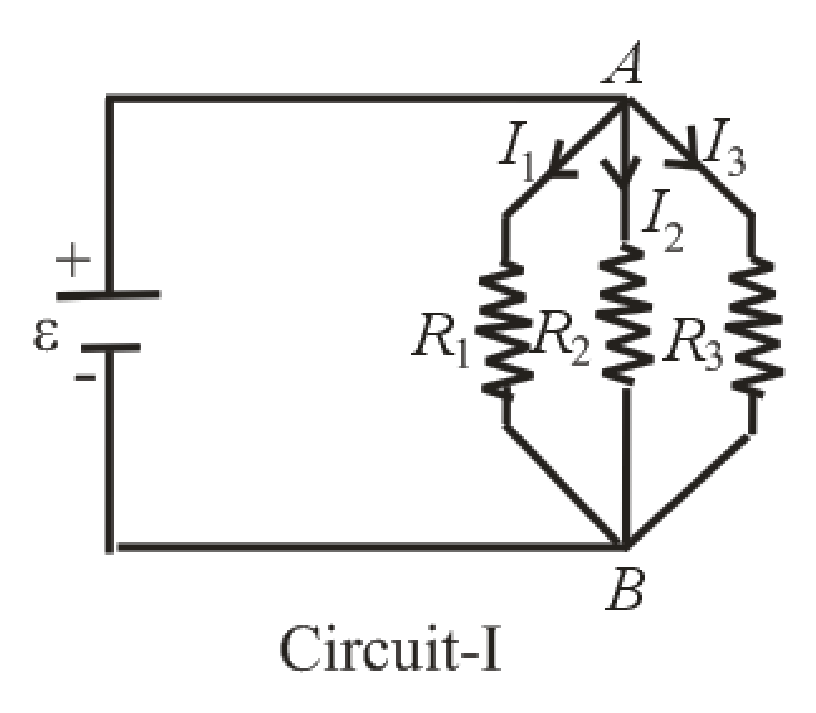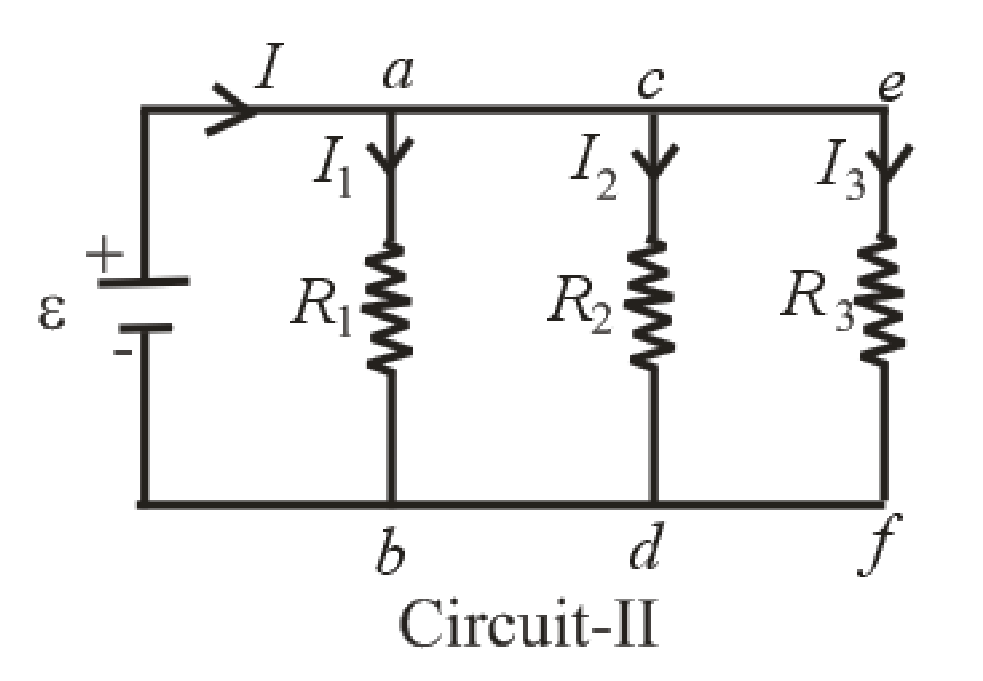
(a)
Find the current through the emf device and each resistor in circuit 1.
(a)
Answer to Problem 39PQ
The current through the Emf device and each resistor in circuit 1 is
Explanation of Solution
According to Kirchhoff’s junction rule, in any junction, the sum of the all the currents entering the junction equals the sum of all the currents exiting the junction.
Redraw the circuit 1 and labeled it as given below

In parallel circuit, voltage across all three resistors is same that means potential difference between node A and node B is same (
According to Ohm’s law,
Here,
Rearrange the equation (I) in terms of total current
Write the expression for equivalent resistance as.
Rearrange the above expression.
Write the expression for current
Here,
Write the expression for current
Here,
Write the expression for current
Here,
Conclusion:
Substitute
Substitute
Substitute
Thus, the current in circuit 1 is
Substitute
Substitute
Substitute
Thus, the current through the Emf device and each resistor in circuit 1 is
(b)
Find the current through the emf device and each resistor in circuit 2 refer to figure P29.28.
(b)
Answer to Problem 39PQ
The current through the Emf device and each resistor in circuit 2 is
Explanation of Solution
According to Kirchhoff’s junction rule, in any junction, the sum of the all the currents entering the junction equals the sum of all the currents exiting the junction.
Redraw the circuit 2 and labeled it as given below.

In parallel circuit 2, voltage across all three resistors is same that means potential difference between node a and node b, node c & node d and node e & node f are same
Write the expression for current
Here,
Write the expression for current
Here,
Write the expression for current
Here,
Conclusion:
Substitute
Substitute
Substitute
Thus, the current in circuit 1 is
Substitute
Substitute
Substitute
Thus, the current for the given circuit resistance is
Want to see more full solutions like this?
Chapter 29 Solutions
EBK WEBASSIGN FOR KATZ'S PHYSICS FOR SC
- No chatgpt plsarrow_forwardhelp me with the experimental set up for the excel i did. the grapharrow_forwardWhich of the following best describes how to calculate the average acceleration of any object? Average acceleration is always halfway between the initial acceleration of an object and its final acceleration. Average acceleration is always equal to the change in velocity of an object divided by the time interval. Average acceleration is always equal to the displacement of an object divided by the time interval. Average acceleration is always equal to the change in speed of an object divided by the time interval.arrow_forward
- The figure shows the velocity versus time graph for a car driving on a straight road. Which of the following best describes the acceleration of the car? v (m/s) t(s) The acceleration of the car is negative and decreasing. The acceleration of the car is constant. The acceleration of the car is positive and increasing. The acceleration of the car is positive and decreasing. The acceleration of the car is negative and increasing.arrow_forwardWhich figure could represent the velocity versus time graph of a motorcycle whose speed is increasing? v (m/s) v (m/s) t(s) t(s)arrow_forwardUnlike speed, velocity is a the statement? Poisition. Direction. Vector. Scalar. quantity. Which one of the following completesarrow_forward
- No chatgpt pls will upvote Already got wrong chatgpt answerarrow_forward3.63 • Leaping the River II. A physics professor did daredevil stunts in his spare time. His last stunt was an attempt to jump across a river on a motorcycle (Fig. P3.63). The takeoff ramp was inclined at 53.0°, the river was 40.0 m wide, and the far bank was 15.0 m lower than the top of the ramp. The river itself was 100 m below the ramp. Ignore air resistance. (a) What should his speed have been at the top of the ramp to have just made it to the edge of the far bank? (b) If his speed was only half the value found in part (a), where did he land? Figure P3.63 53.0° 100 m 40.0 m→ 15.0 marrow_forwardPlease solve and answer the question correctly please. Thank you!!arrow_forward
 Physics for Scientists and Engineers: Foundations...PhysicsISBN:9781133939146Author:Katz, Debora M.Publisher:Cengage Learning
Physics for Scientists and Engineers: Foundations...PhysicsISBN:9781133939146Author:Katz, Debora M.Publisher:Cengage Learning
 Physics for Scientists and Engineers with Modern ...PhysicsISBN:9781337553292Author:Raymond A. Serway, John W. JewettPublisher:Cengage Learning
Physics for Scientists and Engineers with Modern ...PhysicsISBN:9781337553292Author:Raymond A. Serway, John W. JewettPublisher:Cengage Learning Physics for Scientists and Engineers, Technology ...PhysicsISBN:9781305116399Author:Raymond A. Serway, John W. JewettPublisher:Cengage Learning
Physics for Scientists and Engineers, Technology ...PhysicsISBN:9781305116399Author:Raymond A. Serway, John W. JewettPublisher:Cengage Learning Principles of Physics: A Calculus-Based TextPhysicsISBN:9781133104261Author:Raymond A. Serway, John W. JewettPublisher:Cengage Learning
Principles of Physics: A Calculus-Based TextPhysicsISBN:9781133104261Author:Raymond A. Serway, John W. JewettPublisher:Cengage Learning Physics for Scientists and EngineersPhysicsISBN:9781337553278Author:Raymond A. Serway, John W. JewettPublisher:Cengage Learning
Physics for Scientists and EngineersPhysicsISBN:9781337553278Author:Raymond A. Serway, John W. JewettPublisher:Cengage Learning





